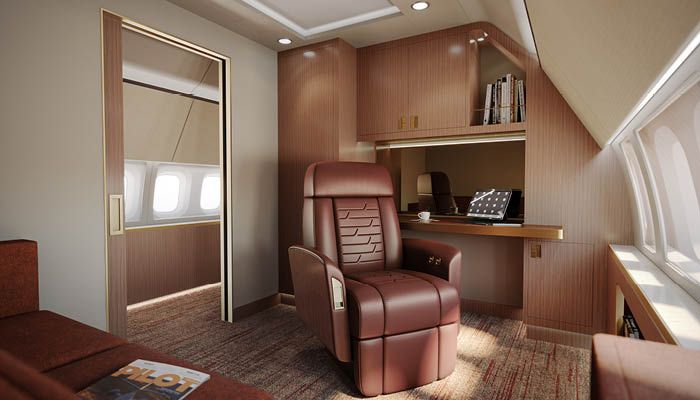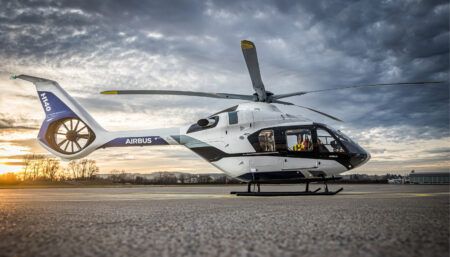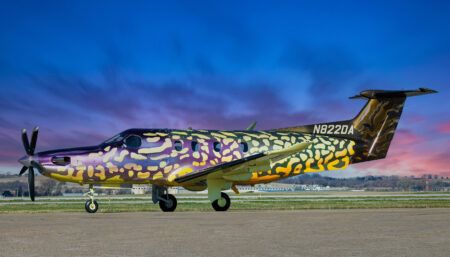In a first for Boeing Business Jets, it is offering the pre-engineered interior module approach for one of its airframes, with the aim of reducing cost and downtime for customers
The strategy of pre-engineering interior zone modules that customers can mix and match to create their preferred business aircraft layout is not a new one. But it is new to Boeing Business Jets (BBJ), where the usual process is delivering green aircraft to be fitted with clean-sheet, 100% custom cabins at third-party completion centres. That fully bespoke approach is still available across the BBJ product line, but at NBAA-BACE 2023, the OEM unveiled an additional option for the BBJ 737-7, the newest member of the BBJ 737 Max family.
The BBJ Select programme allows customers to select from pre-designed layouts – totalling 144 possible cabin combinations – and three colour palettes. By eliminating one-time engineering costs and design work, BBJ proposes the advantages of a lower, more predictable cost; reduced downtime; and turnkey project management. “We launched BBJ Select to simplify the purchase process for our customers by streamlining the design of their cabin,” says Drew Gough, head of BBJ sales, Americas.
Gough says BBJ Select aircraft will spend less time in completion for two principal reasons. “We have pulled forward a lot of the interior engineering work that often takes place after a green aircraft purchase,” he explains. “The BBJ Select catalogue is defined, meaning we are able to shave additional time off the post-green delivery completion process.”
The second factor supporting an expedited timescale is BBJ’s selection of Aloft AeroArchitects and Greenpoint Technologies – through a competitive process – as major partners for the programme. “Interior integration will take place at Aloft AeroArchitects, the long-time supplier of BBJ auxiliary fuel tanks,” explains Gough. “This allows for what is typically a sequential process – the auxiliary fuel tank install then on to completion – to be a concurrent process where the auxiliary tanks and interior work are completed simultaneously. This saves months of time compared with a typical completion.”
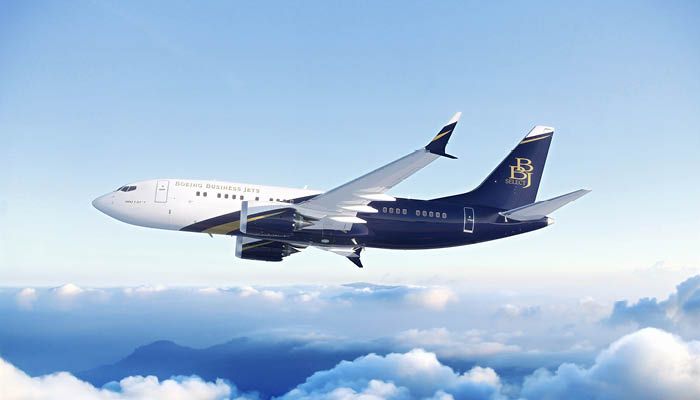
Horses for courses
It’s important customers choose the right programme for them. “Because of BBJ’s history of selling clean-sheet, 100% custom cabins, a potential challenge will be keeping a subset of customers from wanting to alter the BBJ Select modules,” says Gough. “Customers who desire a different layout from the BBJ Select options can still purchase the green aircraft and take it to a completion centre of their choice for a one-off cabin completion.”
On BBJ Select, Boeing is the primary interface for customers, and Aloft is responsible for the interior programme management. Greenpoint’s responsibilities include the interior design – making use of its design centre, which is very close to Boeing’s facility in Seattle, Washington – and manufacturing/engineering of the interior components at Greenpoint’s site in Denton, Texas. When the green aircraft arrives at Aloft in Georgetown, Delaware, Aloft will install the interior kit from Greenpoint, and engineer the integration of CMS, electrical, wastewater, connectivity and other systems, in parallel with the auxiliary fuel tank modification. Aloft’s in-house ODA will issue the STC.
Super group
“We’ve always viewed Greenpoint as a collaboration opportunity,” explains Matt Hill, VP of sales and service at Aloft, on why the companies launched a joint bid in response to Boeing’s RFP. “We tend to focus on narrow-bodies, and Greenpoint’s been ultra-successful on the wide-body market. Our strategy is to outsource or partner on products within the cabin, so there was an obvious collaboration opportunity already there, structurally, between the companies.
Culture was also a big factor. “The two organisations have a very similar spirit,” explains Bret Neely, VP of sales and design at Greenpoint. “It was just an easy process. When we went to carve up the workscope for example, there were no disagreements. We felt together we were an unbeatable team.”
Between them Aloft and Greenpoint have completed around 70 projects, of which 40 are narrow-bodies. “It was hard to imagine an individual entity in our business making as compelling a case,” says Hill.
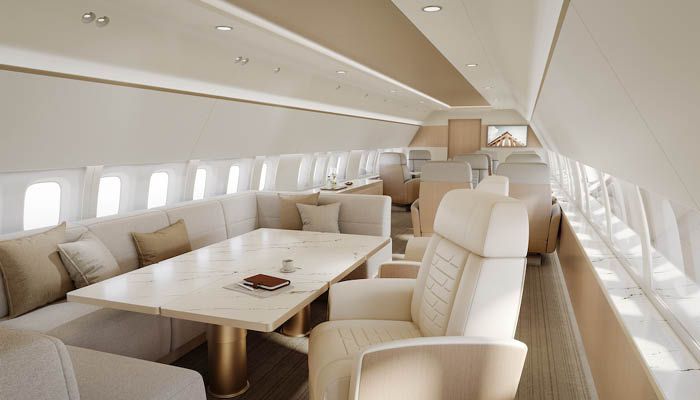
Crowd-pleasers
Cabin options have been chosen to meet the needs of the broadest range of potential customers possible. “You can’t design for the extremes, but what’s the most likely best use case,” says Hill.
Fixed elements include the forward section’s crew rest, galley and VIP lavatory, and the back section’s stateroom and en-suite shower room. In-between are four zones with various options. The forward lounge’s four choices include business-class seating, a divan/cinema setup, club seats, or a club/divan blend. The mid lounge offers three options for club seating. The larger aft lounge’s three choices all provide a divan, seats and a long table in different configurations. Finally, the private room can be set up for meetings, or with a queen-size bed, a lounge-style divan or as more of a private office.
Three’s a charm
There are three design styles: Serene, Midnight and Earthbound. “With each design style, there are supplementary colour choices for specified areas of the cabin,” adds McCahl Troupe, design manager at Greenpoint. “For example, curated colour palettes include additional leather and fabric shades for the client to personalise their seating.”
The programme could be particularly helpful for customers who might be overwhelmed by the choices involved in a bespoke project, Hill suggests. “A pretty fair amount of customers desire to be led through that,” he says. “We want to offer something that allows the client to be more hands-off if they’d like. You want to offer some customisation, but without affecting the efficiency we built in. The quality will be the highest end of luxury, like you’d expect on a completely custom interior; the efficiency is what creates the value. The modularity should not be misconstrued as a sacrifice in any way – the capability of the cabin is as you’d expect.”
A key benefit of modularity can be its flexibility – enabling owners to swap out zones with greater ease as their operational needs change for example.
“The infrastructure will accommodate any zone – the lighting, the oxygen drops, all the stuff behind the scenes is there already to accommodate each of these options,” says Hill. “In today’s world, the pace of change is faster, so the idea that the mission of the owner would change is probably more likely.”
Another benefit of the modular concept, Hill says, is that replacement parts can be quicker to access, and even pre-made. “In ultra-custom world, to decide to make spare cabinet doors or something like that, it’s a different decision,” he says. “Here, there’s essentially a production line of the same structure.”
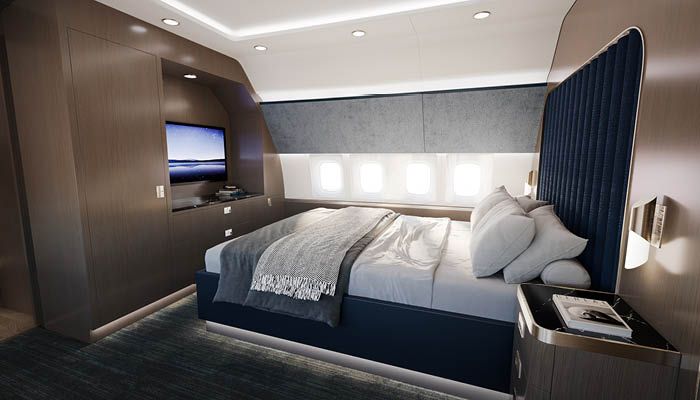
Future focus
In the supplier selection phase, one requirement is for the backbone of electrical systems and IFE/CMS to be applicable well into the future, enabling upgrades by swapping out hardware such as switch panels and monitors, without having to change the entire infrastructure. Neely adds that “we also need suppliers that are going to be around for many, many years”.
“The utopia is we find supply-chain participants that are easily aligned like we are, so we’re looking for strategic long-range vision,” adds Hill.
Overall, the teamwork is the most satisfying aspect of the project for Neely of Greenpoint: “The industry is changing, competition’s changing and trying to go it alone is not as productive as being a team; teamwork is everywhere and it really makes us more effective.”
Hill agrees: “I hope we can do more of it; it’s a benefit to the customer in the end.”
What’s next?
Customers can place orders now for an aircraft ready to enter service as early as 2026, BBJ shares. “BBJ Select is very enticing for our prospective and current BBJ customers, and we are in active conversations with them about the purchase process,” reveals Gough.
He also adds that Boeing will explore the potential market for expanding the BBJ Select cabin approach to other aircraft types in the future.
This feature was written by Izzy Kington and first published in the December 2023/January 2024 edition of Business Jet Interiors International. Click here to read the full article.


